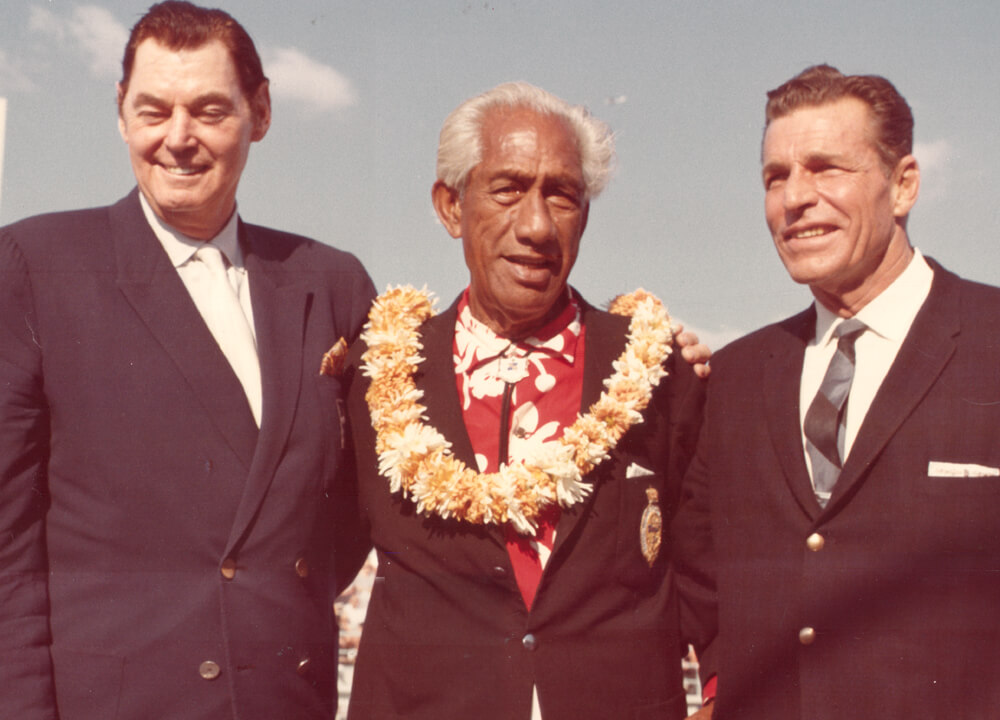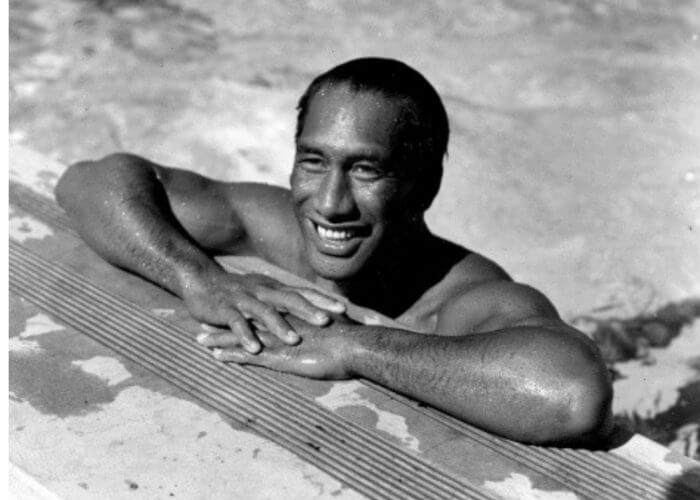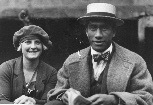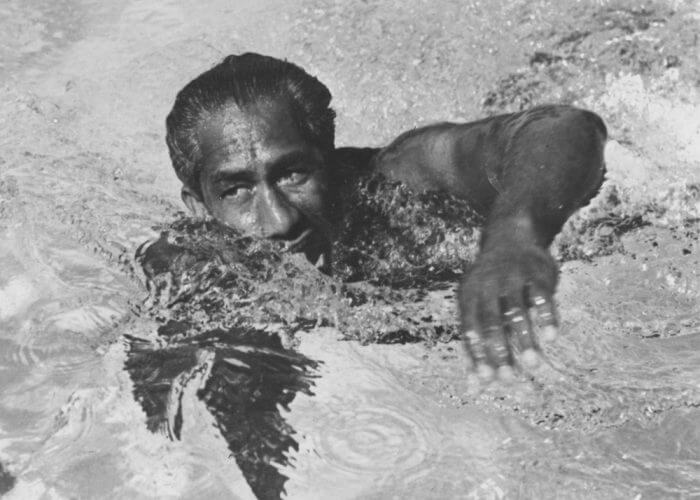A Superstar Of Swim and Surf: The Dual-Sport Talents Of Duke Kahanamoku

Editorial content for the 2021 Tokyo Olympic Games coverage is sponsored by GMX7.
See full event coverage. Follow GMX7 on Instagram at @GMX7training #gmx7

A Superstar Of Swim and Surf: The Dual-Sport Talents Of Duke Kahanamoku
The 100 freestyle has long been a revered event on the Olympic schedule, and American Duke Kahanamoku was an early champion. Also a surfing legend, Kahanamoku remains a legend.
Throughout history, single names have been enough to identify some of the most celebrated athletes. Basketball has Wilt and Michael. The Babe is baseball’s most distinguishable persona. Jack and Tiger define golf, while Gordie and Wayne are hockey royalty. In the pool, a guy known as Duke has been an icon for more than a century.
When a list of the greatest swimmers in history is compiled, it’s easy to tab modern-era athletes for inclusion, given the longer durations of their careers and, subsequently, their loftier medal hauls from events such as the Olympic Games and World Championships. But when a fine eye is taken to the history of the sport, it is impossible to overlook Duke Kahanamoku and all he achieved, both as a swimmer and on a surfboard.
This summer not only signifies the return of the Olympic Games to Tokyo, which first served as host in 1964, but it also marks the 101st anniversary of Kahanamoku capturing his second gold medal in the 100-meter freestyle.
An Original Superstar
Growing up in Hawaii, Kahanamoku was at one with the water from a young age. Whether catching waves on a surfboard or simply swimming, he was naturally comfortable with one of Mother Nature’s gifts to the world. He was so in tune with the water, Kahanamoku was able to move through it like no man ever before.

Duke Kahanamoku. Photo Courtesy: International Swimming Hall of Fame (ISHOF)
In 1911, Kahanamoku made his competitive debut at the Amateur Athletic Union Championships of Hawaii in the grandest fashion. Racing in Honolulu Harbor, Kahanamoku obliterated the world record in the 100-yard freestyle by more than four seconds, lowering the record of the great Charles Daniels, an eight-time Olympic medalist and one of the first legends of the sport.
However, because Kahanamoku was a newcomer and the record was slashed by such a massive margin, officials of the AAU were hesitant to accept its validity.
“Unacceptable. No one swims this fast,” was the statement provided by AAU President Gustav Kirby. “Hawaiian judges alerted to use stopwatches, not alarm clocks! To my mind, this matter should be treated very carefully and with extreme caution before the 100-yard record is to be accepted. If his (55.4) seconds were accepted and he should afterward compete in the U.S. or Europe and be beaten, the correctness of his (55.4) seconds would be seriously questioned as well as the good faith of the AAU. For this reason, I would like to see Kahanamoku beat the fast men first and have the record accepted afterward.”
No problem.
The next year in Stockholm, Kahanamoku claimed the first Olympic title of his career when he cruised to victory in the 100-meter freestyle. If there was doubt concerning his talent prior to the meet, it was now erased. To further cement his status, Kahanamoku remained in Europe after the Games and set a world record in the 100 free in Hamburg, Germany a week later.
Controversy
Kahanamoku’s initial Olympic success was not without controversy, as he nearly didn’t get the opportunity to chase gold. Due to a scheduling misunderstanding, Kahanamoku missed his semifinal race and was seemingly eliminated from contention. But Australian foe Cecil Healy, in an epic show of sportsmanship, argued for a special heat to be held, and officials granted Kahanamoku a reprieve of which he took advantage.
Eight years later, with the Games in Antwerp, Belgium, Kahanamoku made it back-to-back Olympic crowns in the sport’s blue-ribbon event. On the way to gold, he lowered his world record to 1:00.4, nearly becoming the first man to break the minute barrier in the 100-meter freestyle. These 1920 Games, too, brought controversy to a Kahanamoku-involved event, as Aussie William Herald protested the outcome, claiming he was interfered with by American Norman Ross. Officials decided to rerun the final, with Kahanamoku again emerging on top, albeit in a time slower than the world record he posted in the first championship race.
Kahanamoku’s triumph made him the first swimmer to repeat as an Olympic champion by the standards set by the International Olympic Committee. However, it is worth noting that Daniels (100 free) and Great Britain’s Henry Taylor (1500 free) repeated in 1906 and 1908, although the 1906 Intercalated Games were not officially recognized by the IOC for record purposes.

Ethelda Bleibtrey with the other hero of Antwerp 1920, USA teammate Duke Kahanamoku – Photo Courtesy: ISHOF
The repeat by Kahanamoku could have been greater, too, had World War I not called for the cancellation of the 1916 Games, which were scheduled for Berlin. Given that Kahanamoku earned gold medals in the 100 free eight years apart and was the world-record holder in the event, he would have been the overwhelming favorite for gold in 1916, and could have gotten a 44-year jump on Dawn Fraser as the first swimmer to win the same event at three consecutive Olympiads.
An inaugural member of the International Swimming Hall of Fame, which named its first class in 1965, Kahanamoku’s Olympic exploits extended to the 1924 Games in Paris. As Johnny Weissmuller charged to the gold medal in the 100 free, consequently ushering in a changing of the guard, Kahanamoku snared the silver medal at the age of 33, with his brother, Samuel Kahanamoku, picking up the bronze medal. Although Kahanamoku was beaten by Weissmuller by more than two seconds, his longevity was not to be overlooked.
“Long before Michael Phelps and Mark Spitz splashed into the pool, Duke Kahanamoku emerged from the backwaters of Waikiki to become America’s first superstar swimmer,” wrote David Davis in his biography, Waterman: The Life and Times of Duke Kahanamoku. “The original ‘human fish’ won Olympic gold medals, set dozens of world records, and topped the world rankings for more than a decade.”
On The Board
As much as Kahanamoku is known in swimming circles, his designation as the “Father of Modern Surfing” emphasizes his success in a second domain. Lugging a wooden surfboard that measured as long as 16 feet and weighed up to 140 pounds, Kahanamoku sought to spread his love of surfing around the globe. This passion took him to Australia and the coasts of California and New Jersey, where he would promote an interest in youngsters with access to the water.
In addition to encouraging surfing as a fitness activity, Kahanamoku viewed his trips to various locales as an opportunity to pass along the Hawaiian culture and “Aloha spirit.” Kahanamoku was deeply proud of his Hawaiian heritage and sought to share his homeland’s love of the water, friendly atmosphere and hard-working mentality.
 With his surfboard, Kahanamoku also initiated a change in lifeguarding. While in California on June 14, 1925, Kahanamoku was enjoying a day of large waves when he noticed a fishing boat, The Thelma, had capsized while trying to enter Newport Harbor, tossing its 29 crew members into the rough surf. Armed with their boards, Kahanamoku and two friends raced out to the boat and began pulling men from the water. Kahanamoku was credited with rescuing eight crew members, with four additional men saved by Kahanamoku’s friends. While 17 of the men perished, the number could have been much higher.
With his surfboard, Kahanamoku also initiated a change in lifeguarding. While in California on June 14, 1925, Kahanamoku was enjoying a day of large waves when he noticed a fishing boat, The Thelma, had capsized while trying to enter Newport Harbor, tossing its 29 crew members into the rough surf. Armed with their boards, Kahanamoku and two friends raced out to the boat and began pulling men from the water. Kahanamoku was credited with rescuing eight crew members, with four additional men saved by Kahanamoku’s friends. While 17 of the men perished, the number could have been much higher.
“Don’t ask me how I made it, for it was just one long nightmare of trying to shove through what looked like a low Niagara Falls,” Kahanamoku said. “I brought one victim on my board, then two on another trip, possibly three on another, then back for one. It was a delirious shuttle system. In a matter of minutes, we were making rescues. (People were) screaming, gagging, thrashing. Some victims we could not save at all. We lost count of the number of trips we made. Without the boards, we would probably not have been able to rescue a single person.”
Due to what unfolded that day, and thanks to Kahanamoku’s efforts, lifeguarding improved. Suddenly, guards carried boards that enabled them to reach drowning victims with swifter action.
Forever a Legend
A bronze statue of Kahanamoku stands on Waikiki Beach, a reminder of the man’s greatness. Even without that monument, though, there is plenty to remind the sporting world of his excellence. Stories can be told about his prowess in the water. Anecdotes are shared about his surfing skills. Tales are told about his heroics and the influence he had on modern lifeguarding.
Put these legacies together, and it’s no surprise he stands as one of those iconic figures recognized by a single name: Duke.





The Duke will always live in the hearts of all Surfer.